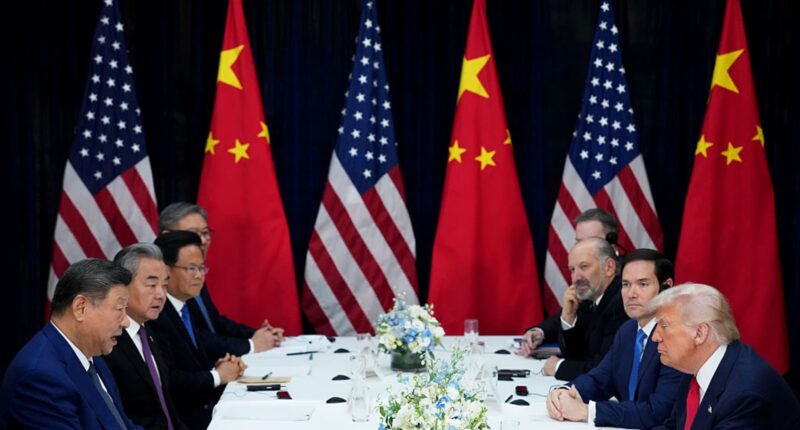Share this @internewscast.com
In a significant diplomatic development, U.S. President Donald Trump and Chinese President Xi Jinping met in Busan, South Korea, leading to a temporary easing of tensions between their nations. The meeting, held on October 30, 2025, at Gimhae Air Base, was marked by key agreements on contentious trade issues, reflecting a cautious step towards cooperation.
Following the high-profile dialogue, Beijing announced a one-year suspension of its export controls on rare earth materials. This move, initially set to commence on October 9, was part of China’s strategic response to trade disputes with the United States. In parallel, Washington agreed to delay the implementation of tariffs linked to fentanyl, which were scheduled to begin on September 29, and included sanctions against Chinese companies placed on the U.S. entity list.
President Trump shared his optimism about the discussions as he departed South Korea on Air Force One. Describing the meeting with Xi as “amazing,” he stated, “A lot of decisions were made,” emphasizing the mutual understanding achieved on the rare earth issue. The agreement reached is set to be revisited annually, allowing both nations to reassess their positions and continue dialogue.
This diplomatic exchange marks a notable pause in the ongoing trade tensions, with both countries showing a willingness to negotiate and find common ground. The resolutions announced offer a window of opportunity for improved relations and economic stability between the two global powers.
Trump told reporters aboard Air Force One as he left South Korea that the meeting with Xi was “amazing” and that “a lot of decisions were made.”
“Rare earth issue has been settled,” Trump said, adding that it was a 1-year agreement that will be negotiated every year.
However, Beijing’s rare earths restrictions announced in early April still remain in place.
“China’s leverage in rare earths and critical minerals processing will continue to surface episodically, effectively capping any escalation in bilateral tensions,” Louise Loo, head of Asia economics at Oxford Economics, said in a note Thursday.
Chinese companies control the majority of the global supply chain for rare earths, which are critical for producing a range of products from semiconductors to missiles. Beijing has ramped up restrictions on exports of critical minerals over the last two years, with a particular focus on limiting their use for military purposes by other countries.
Fentanyl, soybeans, chips
The fentanyl-linked tariffs on Beijing will be lowered to 10% from 20%, effective immediately, Trump said, bringing down the levy on Chinese exports to 47% from 57%.
In return, Beijing will “work very hard to stop fentanyl” and resume purchases of American soybeans and other agricultural products.
China’s commerce ministry said the two countries reached a consensus on cooperating on fentanyl and agricultural products trade, while noting that China will work with the U.S. to resolve TikTok-related issues.
Soybean futures on the Chicago exchange were down 1.6%, while China’s CSI Rare Earths Industry Index was up more than 2%, according to LSEG data.
Tit-for-tat fees on Chinese and U.S.-made ships docking at each countries’ ports will be delayed for a year, according to the Chinese commerce ministry.
On the sale of Nvidia’s chips to China, Trump said the two sides had discussed “a lot of chips” but not the most advanced Blackwell chips. “They are going to be talking to Nvidia and others about taking chips,” he said.
Taiwan was not part of the discussion, Trump said.
The U.S. decision to cut fentanyl-related tariffs to 10% addresses “a key Chinese grievance,” said Han Shen Lin, China director at advisory firm The Asia Group, showing that “Beijing’s efforts to curb exports of fentanyl precursors, long unrecognized by Washington, are finally being acknowledged.”
Trump said he will be going to China in April, followed by Xi’s trip to the U.S., without specifying a timeline for his Chinese counterpart.
The results of the meeting, announced by Trump so far, are “exceeding expectations,” in part thanks to the two leaders’ personal diplomacy that was strong enough not only to halt the escalation but to deliver results that seemed unthinkable, said Alfredo Montufar-Helu, managing director at Ankura Consulting’s GreenPoint Business.
That said, frictions will not go away entirely as several bilateral issues core to the U.S.-China rivalry remain outstanding, he added.
It was the first time that Trump and Xi met in six years and the summit lasted one hour and 40 minutes.

In a statement published by Chinese state media Xinhua after the meeting, Xi called for “dialogue over confrontation,” urging that both sides should maintain regular working-level communication. That’s according to CNBC’s translation of the Chinese statement.
Both sides agreed to strengthen collaboration on trade, energy and economic issues, and to facilitate cultural and people-to-people exchanges, the statement read.
While the trade truce is “welcome news,” any indication of addressing underlying structural matters of concern is missing — such as China’s industrial excess capacity and non-market economy practices — said Wendy Cutler, senior vice president at Asia Society Policy Institute.
That means that the truce is “fragile and tensions are certain to heat up again,” Cutler added.
‘Partners and friends’
Before the meeting, the two leaders struck a conciliatory tone, with Trump calling Xi “an old friend” with whom he has a “very good relationship,” and Xi stressing that China’s economic growth ambitions would not undermine Trump’s vision to “Make America Great Again.”
Tensions between the world’s two economic superpowers have been on a boil this year. The latest escalation came this month, with Beijing export controls and Washington threatening to ban software-powered exports to China.
The U.S. had in recent days shared details about deals they hoped to achieve with China – from restricting the flow of fentanyl to the U.S. to TikTok’s divestiture from its Beijing-based parent ByteDance. Tariffs, tech curbs and rare earths were also on the table for discussion.
Beijing had been more circumspect about the prospects of an agreement, but in a possible sign of thawing relationship, China bought its first cargoes of U.S. soybeans in several months, Reuters reported Wednesday.
Heading into the meeting, Xi shook hands with Trump at the photo-op at Gimhae Air Base in Busan, urging that Washington and Beijing be “friends and partners” in his opening remarks.
Sitting across the table from Trump, the Chinese leader said it was a “great pleasure” to meet the U.S. president for the sixth time, adding that it was only “normal” for the two economic superpowers to have “frictions now and then.”
“China’s development goes hand in hand with your vision to Make America Great Again,” Xi said, according to a readout by the Chinese foreign ministry.
That conciliatory tone marked a notable shift from Xi’s meeting with the former U.S. President Joe Biden late last year, during which the speech highlighted more “inevitable competition” between the two countries, said Yue Su, principal economist at the Economist Intelligence Unit.
While the agreement still lacks a “strong structural foundation” and could easily be reversed, both sides are likely to stick with it in the near term to signal goodwill, Su added.









